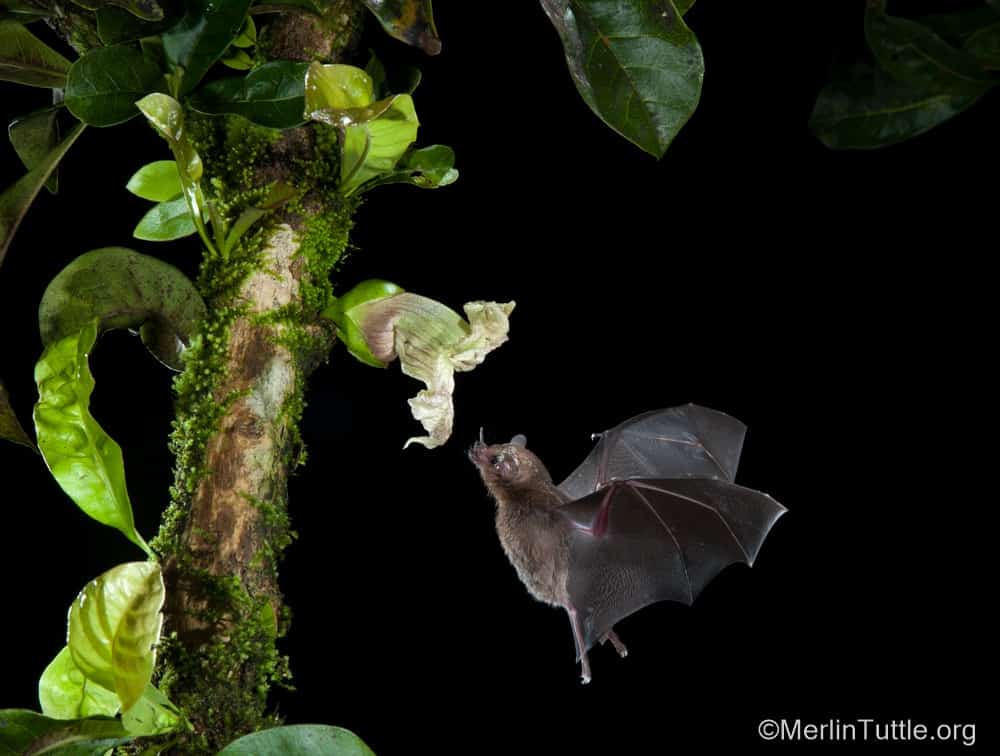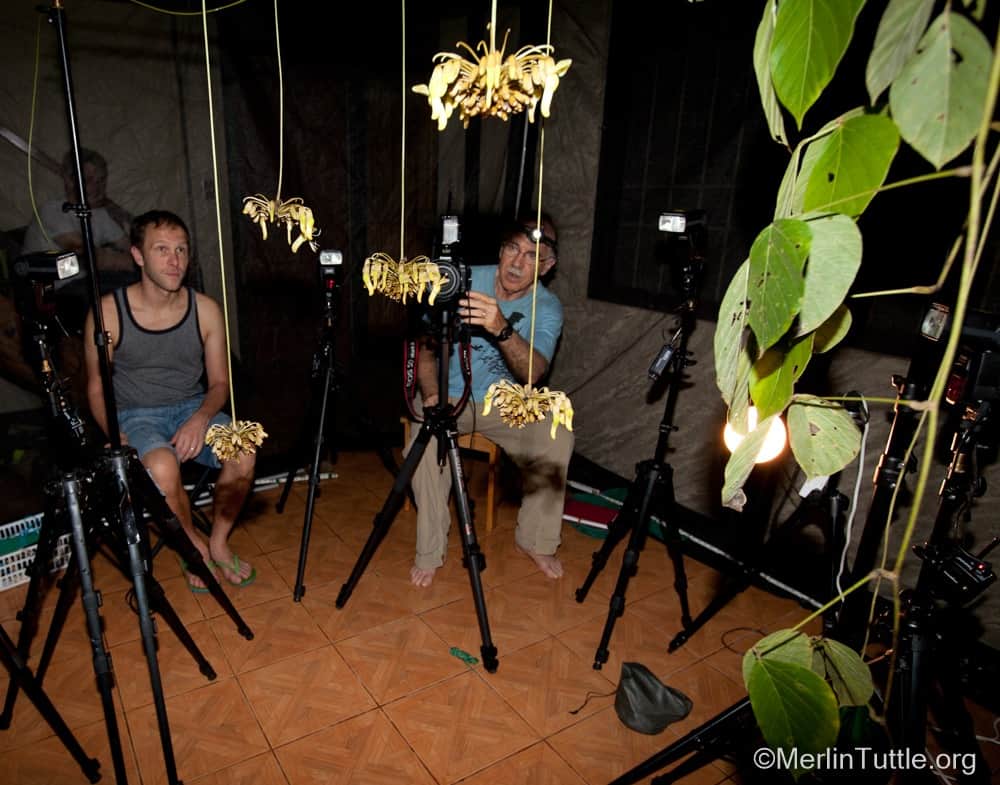Challenging torrential rains countered by cooperative bats in Costa Rica
Merlin and MTBC team members spent 19 days in Costa Rica last November on a filming trip for “Bat City” with its Director and Emmy
In October of 2011, Merlin, his wife Paula, and I, accompanied by National Geographic science writer Susan McGrath, began the incredibly difficult task of, for the first time, documenting a wide range of highly specialized flower adaptations to facilitate bat visitation in Costa Rica, Cuba, and Ecuador. Following three months of little sleep, red tape, floods, terrible roads, and seemingly endless searches, we finally were able to photographically document the amazing adaptations of very special plants, echo vines, old man’s beard cactus, and sea bean vines, which attract nectar bats with their acoustics (original project report).
Nectar bats must make hundreds of visits to flowers every night to find enough nectar to survive. As one can imagine, finding small flowers in the dense vegetation of a tropical forest can be challenging. But plants have evolved exceptional adaptations to help bats find their flowers. First, they provide special odors, often like garlic, cabbage, or sulfur, not attractive for humans but bats love them! Many bat-pollinated flowers have thick, waxy surfaces that reflect exceptionally strong echoes, helping bats use echolocation to find them from greater distances.
A few flowers even provide conspicuous echo-reflectors to help guide bats to their nectaries. These reflectors stand out through a wide radiation pattern, which means that bats receive loud echoes audible from many directions. They basically work like an acoustic cat’s eye (retroreflector). And they also reflect a unique spectral signature, like a fingerprint, which bats can easily identify. Behavioral experiments show that if these reflectors are missing or blocked with a piece of cotton, the flowers are rarely visited by bats, demonstrating their importance.
The most specialized flowers are found in relatively stable, tropical areas. In locations where climate and associated pollinators are less predictable, many plants hedge their bets by opening at night but remaining open and receptive for some or all the following day. This serves as insurance in case bats don’t visit. The rare echo vine (Marcgravia evenia) is such a species. It grows in low abundance in some of Cuba’s densest tropical forests. Bright red, and frequently visited by hummingbirds, it was long believed to be mainly hummingbird-pollinated.
A Leache’s long-tongued bat (Monophyllus redmoni) pollinating Marcgravia evenia in Cuba, and a Cuban emerald hummingbird is getting a free meal without pollinating. The upturned leaf reflects bat echolocation, guiding their approach like airport landing lights guide pilots at night. In fact, neither insects nor hummingbirds are large enough to contact the plant’s reproductive organs, so even when they find Marcgravia flowers, they rarely achieve pollination.

However, when my supervisor, Otto von Helversen and I for the first time saw this plant in bloom with an upturned concave-shaped leaf above each cluster of hanging flowers we immediately suspected that these leaves had to be acoustic reflectors to guide bats. When we returned with an infrared light and camcorder, we indeed found Leach’s long-tongued bats visiting. Subsequent lab experiments confirmed the function of the upturned leaves. They reliably guide bats to the flowers with their conspicuous echo signature.
In Ecuador, the old man’s beard cactus (Espostoa frutescens) has developed a unique combination of adaptations. Unlike the flowers already described, Espostoa flowers are less reflective. Nevertheless, it still manages to acoustically advertise. This cactus surrounds its flowers with a dense sound absorbing fur-like material. The fur dampens nearby background reflections, making the flower contrastingly more conspicuous to echolocating bats.
Sea bean vines (Mucuna holtoni) of Central America are especially adapted for exclusive pollination by small bats. Their flowers hang in groups called inflorescences on extra-long stems known as peduncles. This protects against giving free drinks to small opossums and other climbing mammals. They also avoid most bees and hummingbirds by not opening or providing nectar till well after dark. When they are finally ready, they open a petal that serves as a reflector to guide approaching bats to a keyhole-like slit only a millimeter or two in width. When a bat dips its long tongue into this opening it triggers spring-loaded anthers to pop out and fire pollen onto the bat’s rump. All this happens in just a tiny fraction of a second.
Left: A brown long-tongued bat (Glossophaga commissarisi) approaches a “ripe” sea bean flower. Middle: A split second later, its tongue enters a 2 mm-wide opening like a key in a lock. Right: The flower has fired pollen onto the bat’s rump just as its departing. The bat’s echolocation is transmitted through its nose using its nose-leaf to transmit sound into the flower’s reflective petal. The sea bean (Mucuna holtonii) is a legume that grows along streams, rivers and other rain forest edges from southern Mexico and Belize throughout Central America. Bats ignore this flower until it raises a flag-like petal that reflects the bat’s signals.
So why do some plants go to such lengths to attract only bats? The answer is simple. Bats are superstars of the pollination world. They carry more pollen farther than any other animal. It’s a combination of dense fur, outstanding spatial memory and huge home ranges. For plants that have patchy distribution patterns, this is an especially essential combination. As habitats become ever more fragmented, bats are increasingly important for genetic exchange between distant plants beyond the reach of other pollinators.
Furthermore, bat services extend far beyond ecosystem health. In Mexico tequila and mescal production worth more than a billion dollars annually, relies on bat-pollinated agave plants. In East Africa vitamin sales from bat-pollinated baobab trees sell for a billion dollars annually, and in Southeast Asia durian fruit that cannot be grown even in orchards without pollinating bats, sells for more than 10 billion annually. And countless additional products benefit from bat pollination. For example, a recent study showed that if bats are excluded from Mexico’s pitaya (fruit of organ pipe cactus) fields, they produce 35% less fruit, and the remaining fruit is less sweet and of reduced quality.
Through Merlin’s highspeed photography of bats and hummingbirds in Cuba we demonstrated that bats are the virtually exclusive pollinators of echo vines and we could for the first time see in detail the complex pollination mechanism of this flower. While working in Merlin’s portable studio in Cuba and Ecuador, I was able to make key echo recordings as bats approached such flowers. Beyond learning the essential ecosystem roles of nectar-feeding bats, our knowledge of adaptations between them and plants can help us in our everyday lives.

Our cars, robots, and autonomous devices are increasingly equipped with sonar sensors which function just like the biosonar of bats. Knowledge of the shape and function of floral sonar reflectors is proving useful. Collaborating with engineers from Antwerp University we recently realized that reflectors inspired by floral forms can help robots navigate through unknown environments. Using 3D scan and printing techniques we designed the perfect bioinspired reflector mimicking Cuban echo vine reflectors and tested them in an experiment. In a study published this year (2020), in the Proceedings of The National Academy of Sciences, we demonstrated that a robot steered solely by sonar could perfectly navigate an unknown path using these floral-inspired reflectors as waypoints.
Clearly, knowledge of adaptions between nectar-bats and flowers can lead to safer autonomous navigation. And there is still a lot to learn. Other studies show that bats have incredibly fine sonar resolution. They can recognize structures of only a few hundred micrometers and can identify similar objects solely based on their echoes. There is still much to be discovered from bats.
Ralph Simon is a German sensory ecologist and staff scientist at Nuremberg Zoo and a guest researcher at Antwerp University (CoSystem Lab). For his PhD he used an artificial sonar head to collect ultrasound echos from 64 species of bat-pollinated flowers in Central and South America, discovering an amazing world of adaptations.
Love our content? Support us by sharing it!
Merlin and MTBC team members spent 19 days in Costa Rica last November on a filming trip for “Bat City” with its Director and Emmy
Bats can use sounds in many complex ways. They can sing and even have different dialects… When imagining a bat, the first thoughts that come
Thanks to all the Join the Nightlife: Bats and Agriculture attendees who joined us out in the field this year! Guests got hands-on experience with
Supporter and friend of MTBC, Australian conservation and animal welfare photojournalist Doug Gimesy, had his images recognized in two categories at the recent Siena International
2024 © Merlin Tuttle’s Bat Conservation. All rights reserved.
Madelline Mathis has a degree in environmental studies from Rollins College and a passion for wildlife conservation. She is an outstanding nature photographer who has worked extensively with Merlin and other MTBC staff studying and photographing bats in Mozambique, Cuba, Costa Rica, and Texas. Following college graduation, she was employed as an environmental specialist for the Florida Department of Environmental Protection. She subsequently founded the Florida chapter of the International DarkSky Association and currently serves on the board of DarkSky Texas. She also serves on the board of Houston Wilderness and was appointed to the Austin Water Resource Community Planning Task Force.
Michael Lazari Karapetian has over twenty years of investment management experience. He has a degree in business management, is a certified NBA agent, and gained early experience as a money manager for the Bank of America where he established model portfolios for high-net-worth clients. In 2003 he founded Lazari Capital Management, Inc. and Lazari Asset Management, Inc. He is President and CIO of both and manages over a half a billion in assets. In his personal time he champions philanthropic causes. He serves on the board of Moravian College and has a strong affinity for wildlife, both funding and volunteering on behalf of endangered species.